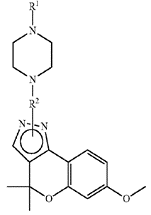BACKGROUND
The G protein-coupled receptor GPR55 is a ubiquitously expressed protein that has been linked to several different diseases or conditions making it a potential therapeutic target. Agonists acting on GPR55 are expected to play a therapeutic role in diabetes, gut mobility, bone turnover, and diseases of the cardiovascular and central nervous systems. Antagonists are also expected to influence bone turnover, while also affecting treatment of inflammation, pain, cancer, and obesity. Targeting this receptor could therefore provide a means to modulate several different diseases.
TECHNOLOGY
Researchers at the University of Toronto have developed chromenopyrazole-based structures (Figure 1) as agonists for GPR55. They have found that the compounds act on GPR55 selectively and are thus useful for modulating processes in which GPR55 is involved. These molecules have been tested in cells and pharmacokinetic parameters have been estimated in silico.
Figure 1. Chromenopyrazole-based structures as agonists for GPR55.
COMPETITIVE ADVANTAGE
- EC50 value of ~ 0.4 nM for best compound
- 7x lower than the endogenous ligand
- Potential for multi-disease targeting
APPLICATIONS
- GPR55-related Diseases
- Diabetes
- Parkinson's disease
- Multiple sclerosis
- Neuropathic pain
- Osteoporosis
INTELLECTUAL PROPERTY
- National Filings
- Issued Patents (DE, ES, US)
PROJECT STATUS
Proof-of-concept studies have been conducted. Fourteen chromenopyrazole-based structures were synthesized and characterized using NMR. The activity of the compounds was tested using real-time cell impedance measurements. The assays were performed on regular HEK293 cells and those overexpressing GPR55. The pharmacokinetic profile of exemplary compounds was determined in silico.





